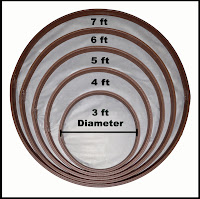
It's never good when turf is growing against the trunk because of the potential of damaging the root flare when using a string trimmer to trim this turf. Once the root flare is damaged the tree will be susceptible to disease and pest that can potential kill the tree. In addition, a damaged root flare will restrict the movement of water from the roots up the trunk to the crown of the tree. Installing a tree well or a tree ring will protect the tree from these potential problem and enhance the appearance of the tree. Using a mulch material, in addition, will prevent moisture loss through evaporation and prevent any unwanted weeds from germinating.
Many materials are available to construct tree rings. Metal edgings look great when first installed, but overtime the grass will creep under or climb over the top because they are so thin. Concrete curbing would be a poor choice because as the tree matures the roots will lift, crack and break the curbing. Many plastic edgings may work, but most poly-board style edgings are not capable of bending on a tight radius, or when bent on a tight radius full have failure points at their weak connecting joints. Knucklehead edging tree rings are the perfect product! Being preformed into rings requires minimal staking and only take a few minutes to install. In addition, Knucklehead Edging tree rings are available with an optional weed barrier to prevent turf from growing into your tree well.









